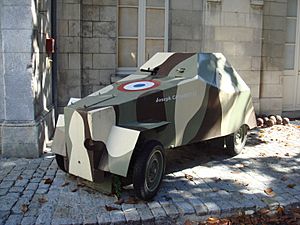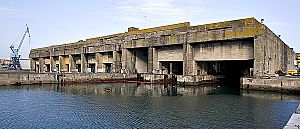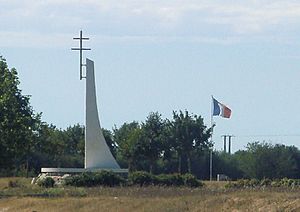Allied siege of La Rochelle facts for kids
Quick facts for kids Allied siege of La Rochelle (1944–1945) |
|||||||
|---|---|---|---|---|---|---|---|
| Part of World War II | |||||||
 French Army armoured car which participated in the liberation of La Rochelle in 1945. Musée d'Orbigny-Bernon. |
|||||||
|
|||||||
| Belligerents | |||||||
| Commanders and leaders | |||||||
| Strength | |||||||
| 22,000 | |||||||
The Allied siege of La Rochelle was a long event during World War II (1944–1945). It happened when Allied forces were taking back France. La Rochelle was a key German naval base on the Atlantic Ocean. From here, German submarines called U-boats launched attacks.
La Rochelle, along with other ports like Royan and Saint-Nazaire, became "Atlantic pockets". These were areas still held by German forces. The main Allied invasion bypassed these pockets, just like Dunkirk on the North Sea. La Rochelle was freed only at the very end of the war. This was nine months after the Liberation of Paris. The city was finally liberated after Germany surrendered on 8 May 1945.
The Siege of La Rochelle
The Allied siege of La Rochelle lasted from September 1944 to May 1945. There was no heavy bombing of the city during this time. La Rochelle stayed under German control until the war ended. Other "Atlantic pockets" like Saint-Nazaire and Lorient also remained in German hands.
The Allies decided it was better to surround the city than to attack it directly. They knew the city would eventually fall when the war ended. The German army, known as the Wehrmacht, had made the ports very strong. This was to stop the Allies from using them. It also kept the threat of U-boat attacks alive for Allied ships.

About 39,500 French civilians lived under German rule in La Rochelle. Vice-Admiral Ernst Schirlitz was the German commander there from 1943. He stayed until the war ended. The German army in La Rochelle had 22,000 soldiers. During the siege, the Allies allowed some supplies into the city. This included electricity and wood. This helped the people living inside the city walls.
The French and German forces in La Rochelle made an agreement. The French would not attack the city. In return, the Germans would not destroy the port buildings in La Rochelle-La Pallice.
La Rochelle was surrounded very well by the Allies. The city suffered during the siege. Allied air attacks damaged the harbor facilities. Because of this, the Germans could not launch many U-boat attacks. However, a Luftwaffe (German air force) plane managed to get through the blockade every week. It brought supplies to the German soldiers. To boost their spirits, a propaganda movie called Kolberg was sent to them. This movie celebrated resistance against the French in 1806. It was shown in Berlin and La Rochelle at the same time on 30 January 1945.
In spring 1945, General Edgard de Larminat took charge of French forces in the area. His goal was to capture La Rochelle. The United States offered help with supplies and air support. The first nearby German-held area to be attacked was the Royan pocket. Royan was heavily bombed by 1,000 planes. The city was destroyed, and 1,500 civilians died. La Rochelle avoided this terrible fate. Royan was seen as more important at the time. This was because of its key location on the Gironde River. The planned attack on La Rochelle, called Opération Mousquetaire, was canceled when Germany surrendered.
La Rochelle was one of the last French cities to be freed in 1945. It surrendered to the Allies on 7 May 1945. The official surrender ceremony happened on 8 May 1945, at 11:45 PM. The Germans in Dunkirk surrendered on 9 May, and in Saint-Nazaire on 11 May.
The 4e régiment de Zouaves, a French army unit, played a special role in freeing La Rochelle.
Legacy of the Siege
US troops stayed in the area around La Rochelle for many years. They were part of the Atlantic Alliance. Their bases were in La Rochelle, Croix-Chapeau, Bussac-Forêt, and Saint-Jean-d'Angély (Fontenet). They remained there until 1966. That year, Charles de Gaulle pulled France out of the military part of NATO. He then ordered the closure of NATO bases in France.
On 7 September 1996, a monument was built near the edge of the La Rochelle pocket. It is near Saint-Sauveur-d'Aunis. This monument is called the "Mémorial de la poche de la Rochelle". It honors the soldiers who died during the operation.
See also
- Das Boot
- Liberation of France


